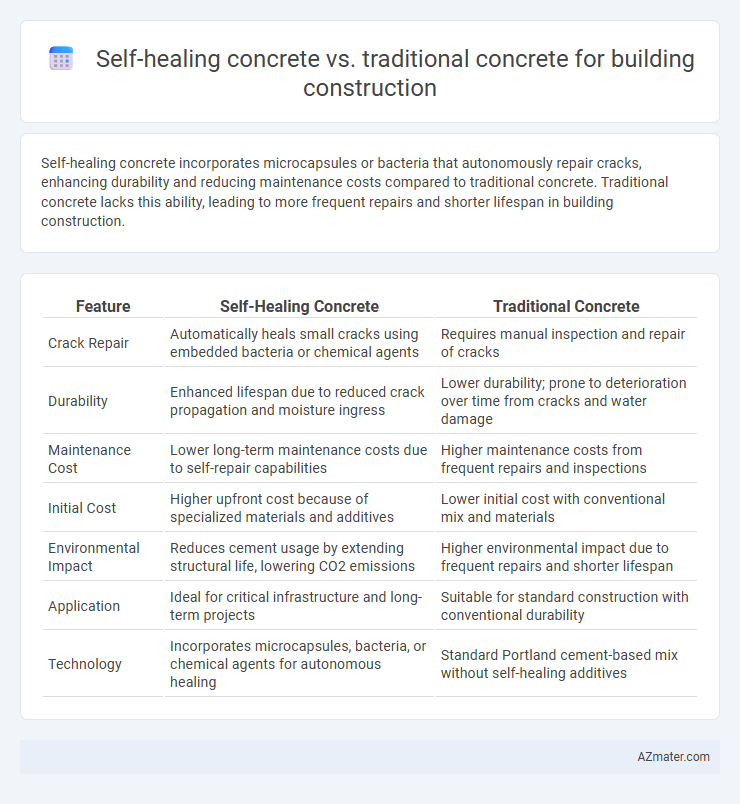Self-healing concrete incorporates microcapsules or bacteria that autonomously repair cracks, enhancing durability and reducing maintenance costs compared to traditional concrete. Traditional concrete lacks this ability, leading to more frequent repairs and shorter lifespan in building construction.
Table of Comparison
| Feature | Self-Healing Concrete | Traditional Concrete |
|---|---|---|
| Crack Repair | Automatically heals small cracks using embedded bacteria or chemical agents | Requires manual inspection and repair of cracks |
| Durability | Enhanced lifespan due to reduced crack propagation and moisture ingress | Lower durability; prone to deterioration over time from cracks and water damage |
| Maintenance Cost | Lower long-term maintenance costs due to self-repair capabilities | Higher maintenance costs from frequent repairs and inspections |
| Initial Cost | Higher upfront cost because of specialized materials and additives | Lower initial cost with conventional mix and materials |
| Environmental Impact | Reduces cement usage by extending structural life, lowering CO2 emissions | Higher environmental impact due to frequent repairs and shorter lifespan |
| Application | Ideal for critical infrastructure and long-term projects | Suitable for standard construction with conventional durability |
| Technology | Incorporates microcapsules, bacteria, or chemical agents for autonomous healing | Standard Portland cement-based mix without self-healing additives |
Introduction to Self-Healing Concrete and Traditional Concrete
Self-healing concrete incorporates microcapsules or bacteria that activate upon cracking, promoting autonomous repair and enhancing durability, thus reducing maintenance costs in building construction. Traditional concrete, composed of cement, water, and aggregates, relies on manual repairs when cracks occur, which can lead to structural weakness over time and increased long-term expenses. Innovations in self-healing concrete aim to improve the lifespan and sustainability of construction materials compared to conventional concrete methods.
How Self-Healing Concrete Works
Self-healing concrete contains embedded microcapsules or bacteria that activate upon crack formation, releasing healing agents like calcium carbonate to seal fissures autonomously. This biological or chemical process restores structural integrity without external intervention, significantly reducing maintenance frequency. In contrast, traditional concrete lacks this adaptive capability, often requiring manual repairs to address cracks and prevent further damage.
Composition Differences: Self-Healing vs Traditional Concrete
Self-healing concrete incorporates specialized bacteria, polymeric microcapsules, or crystalline admixtures that activate upon crack formation to precipitate calcium carbonate, effectively sealing fissures and extending durability. Traditional concrete relies on a cement, water, and aggregate mix without such bio- or chemical agents, making it susceptible to crack propagation and eventual structural compromise. The advanced composition of self-healing concrete reduces maintenance costs and enhances longevity, contrasting with the standard mixture's vulnerability to environmental stressors.
Performance and Durability Comparison
Self-healing concrete significantly outperforms traditional concrete in durability by autonomously repairing micro-cracks, thereby preventing water ingress and reducing corrosion risks of reinforcing steel. This enhanced performance extends the service life of structures and minimizes maintenance costs compared to conventional concrete, which relies solely on external repairs after crack formation. Studies show that self-healing concrete can restore up to 90% of its original strength post-cracking, whereas traditional concrete often experiences progressive deterioration under similar conditions.
Cost Analysis: Initial Investment and Long-term Savings
Self-healing concrete demands a higher initial investment due to advanced materials and technology integration, while traditional concrete offers lower upfront costs but may incur frequent maintenance expenses. Long-term savings with self-healing concrete result from reduced repair frequency and extended structural lifespan, significantly lowering lifecycle costs. Cost-benefit analysis shows self-healing concrete improves economic efficiency in critical infrastructure by minimizing downtime and maintenance budgets over decades.
Sustainability and Environmental Impact
Self-healing concrete enhances sustainability by extending the lifespan of structures and reducing the need for repairs, leading to lower consumption of raw materials and energy compared to traditional concrete. This innovative material incorporates bacteria or chemical agents that activate upon cracking, sealing fissures autonomously and thus minimizing environmental impact through decreased CO2 emissions from maintenance activities. In contrast, traditional concrete suffers from durability limitations that result in frequent repairs and higher overall carbon footprints associated with production, transportation, and application processes.
Maintenance Requirements and Lifecycle
Self-healing concrete significantly reduces maintenance requirements by automatically repairing microcracks through embedded bacteria or chemical agents, extending the lifespan of structures. Traditional concrete necessitates frequent inspections and costly repairs due to its inability to address internal damage autonomously. Lifecycle costs for buildings utilizing self-healing concrete are lower, as enhanced durability minimizes structural degradation and reduces long-term repair interventions.
Applications in Modern Building Construction
Self-healing concrete enhances durability by autonomously repairing micro-cracks, significantly reducing maintenance costs in modern building construction applications such as bridges, tunnels, and high-rise structures. Traditional concrete, while widely used and cost-effective, requires frequent inspections and repairs due to its susceptibility to cracking and environmental damage. The integration of self-healing concrete increases structural longevity and sustainability, making it a preferred choice for smart infrastructure projects and eco-friendly developments.
Challenges and Limitations of Both Concrete Types
Self-healing concrete faces challenges such as high production costs and limited effectiveness under extreme environmental conditions, restricting its widespread adoption in large-scale building construction. Traditional concrete exhibits limitations including susceptibility to cracking, corrosion of reinforcement, and reduced durability, leading to frequent maintenance and higher lifecycle costs. Both concrete types struggle with optimizing performance under varying structural loads and environmental factors, necessitating further research for enhanced long-term resilience.
Future Prospects and Industry Adoption
Self-healing concrete offers promising future prospects in building construction due to its ability to autonomously repair cracks, significantly extending the lifespan of structures and reducing maintenance costs compared to traditional concrete. The construction industry is increasingly adopting this advanced material as sustainability and durability become critical priorities, with research focusing on enhancing microbial and chemical healing mechanisms for large-scale applications. Growing investments and pilot projects worldwide indicate a strong shift toward integrating self-healing concrete in infrastructure development, aiming to improve resilience against environmental stress and reduce lifecycle carbon footprints.

Infographic: Self-healing concrete vs Traditional concrete for Building construction
 azmater.com
azmater.com